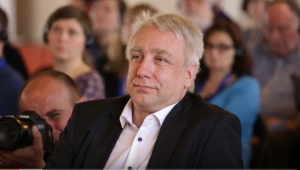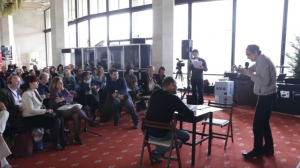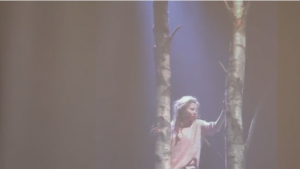Role(s) Of Arts in Migration Europe?
“/…/The legendary ping pong club is being restaged at mumok in order to reactivate Július Koller’s goal of transforming art and its institutions. Visitors are invited to play, exchange shots, opinions, and positions. In the light of our current crisis of democracy, Koller’s fair-play game seems all the more topical today.”
These are the last couple of sentences I read on one of the white walls of the 5th floor at Museum Moderner Kunst Stiftung Ludwig Wien (MUMOK), overhearing the reverberating sound of the ping pong ball, echoing distinctively in the hall as a group of visitors is playing on one of the tables behind me. It feels like the fading away resonance of each ball is gently asking a question, taken up by the next one. The soft, but insistent rhythm of this respectful discussion sticks to my mind for the rest of the day. Then I leave the Museumquartier, cross the slightly slippery, frosted street and enter into Volkstheater, where the Democracy in a Migration Society roundtable is to take place.
While the participants are getting seated and some of the chairs on the stage of the Rote Bar are producing cracking noises, I am still thinking about Július Koller. About his artistic presence; his boldness in transforming himself into an object of art; his fine irony; his healthy connection to the current socio-political context and its various layers; his ability to preserve his personal navigation system, despite the abrupt changes he witnesses. Born in former Czechoslovakia in 1939 and died in Slovakia in 2007, he is among the most influential conceptual artists of the epoch. He lived and created in both a Europe that was disunited by the Iron Curtain and in a Europe that was united by the European Union. But, in an impressive manner, he managed to preserve his artistic neutrality and the needed critical distance so that he could illustrate and comment on what happens in everyday life, the world of art and politics, and how they are intertwined. What is more, he also succeeded in accomplishing his attempts in reconfiguring the principles of the familiar, by inventing new, temporary “cultural situations”, as Koller calls them; and he does it through minimalistic, simple yet right at their place gestures.
The Ping-Pong Club exhibition, originally shown in Bratislava in 1970, and now restaged at the MUMOK as part of his retrospective, is just one example. In it, Koller invites the visitors to play table tennis in the exhibition room, to pass on to one another the ping pong ball based on the preexisting set of rules of the game, which guarantee its equality and fairness. And propels participants forward into consideration of rules as foundation of human relations on both interpersonal and collective level. This way Koller transforms the well-known sports game into a multifaceted metaphor; but also poses many questions. And, as his fans know, the question mark is not just an artistic tool in his work, but an important, aesthetic gesture that he employs repeatedly.
Interrogative sentences turn out to be the prevailing linguistic structure used by the participants at the roundtable – Meera Jamal, Ioanna Petrisi, Tina Leisch, Monika Mokre, Vlad Troitzkyi and the moderator Corinna Milborn – as well. Similarly to the ping pong game, the organizers have managed to ground the debate on a solid, preliminary agreed on basis. An essential component of which is the insistence not to look at the current situation of flux of people, coming to the continent from the Middle East, Central Asia and Africa, as a crisis, as a singular, extraordinary event, that needs to be resolved in order to return to normality. Instead, the perspective chosen is the one, admitting that this situation is already a fact, this is the new normality and that means that the attitude towards it, the approaches and the solutions should be long-term ones, and not at all momentary.
For the purposes of even more thorough and constructive rationalization of this notion, it might have been wise to consider some example of the extremely rich, migrant past of Europe. Stretching through the poles of history of domination on continents outside, through the specific relation inside between East and West, North and South, it all offers a significant amount of food for thought. Yet the span and the attention of the roundtable focus on the topic of the refugees as the most acute situation that needs urgent actions and strategies. Logically, at first the conversation sets off from the most painful and pressing issues that are often commented: protection of human rights, access to information, and mechanisms for their enforcement, conditions and services available at the detention centers, procedures for refugee status determination.
Slowly, but yet visibly, as opinions and examples are being exchanged over the table as ping pong balls, a second layer of questions begins to sneak in and gradually shifts the perspective. Inevitably issues of identity are touched upon and the topic of who/what is Europe and who “we” are is already here. It arises most clearly after Vlad Troitzkyi’s statement, in which he metaphorically describes Europe as a library, precious with its collection, in which everyone is welcome to choose a book and read it, yet all readers have to respect the rules and should not bring in any food or beverages, for instance. Tina Leisch in turn suggests that she prefers to think of Europe through the imagery of the supermarket, which is largely accessible for citizens from all walks of life and everyone can contribute to its shelves.
And there is a moment of silence; at least in my head; because a large, important space is opened up for the reconsideration of several major topics. Particularly crucial is the logic of the recognizing that we are already living in migration societies, and this is how it is going to be. To begin with, this is the starting point of the very old but still needed discussion on the access to culture, elitism, and the intellectual exclusivity of certain areas of the environment and given institutions. Then, this is the moment to initiate the talk on the role(s) of arts in society, especially in the frame of new pressing social issues. At this point of the debate the following questions also belong: what is the role of theatre, with its various forms and subgenres, in the different European societies today in relationship to their own members; what kind of hierarchies are present; and what could be the theatre’s involvement and contribution in the process of integration of newcomers; how should various theatrical structures react that are different in size, funding and presence, ranging from the state-run theatres and independent collectives to individual artists; where should the stage itself direct its gaze, and what artistic means are best to be employed? And, of course, many, many other questions, that are already anticipated, briefly mentioned or elaborated by the speakers at the round table.
Again, none of them is a new one, but the changed social reality has produced a new “cultural situation” which casts a different light; and offers fresh opportunities, but also requires us to negotiate the given rules of the game in order to be able to play it together. And not at all to claim that anything is a tabula rasa, but rather to be honest first of all with ourselves about the state of affairs, and then to attempt to openly state rules that, to the greatest extent possible, are fair and acceptable for everyone.
Furthermore, directly or implicitly, the roundtable offers some initial potential directions where to look for the answers. To begin with, I just simply slide my glance up and down the still preserved, though beginning to decay at certain spots, lavish interior of the 19th century building of Volkstheater, where we are. Its name literary means “people’s theatre”, and it is among the major institutions of its size and kind in Vienna. And this particular institution, together with Union of Theatres of Europe, a prominent trans–European network, is organizing such a roundtable for the second time. This in itself already is a clear telltale sign.
Other two possible directions to look for some hints are alluded by the two participants in the discussion, who are, among other things, theatre professionals. Vlad Troitzkyi emphasizes the fact that theatre is one of the spaces where challenging social questions can be posed due to its ability to profoundly unfold and express troubling social situations. And it does so exhaustively, including the aspects that often remain unsaid in personal and political talks. Tina Leisch builds up on that by confirming her belief in the effectiveness of theatre, but only when it succeeds to break out of the elitist, intellectual bubble, which many of the prominent theatrical institutions inhabit.
And a step further would be to look into the own practice of the two speakers quoted above. Troitzkyi is the artistic director of the prominent Ukrainian independent theatre DakhaBrakha. During the protests at Maidan Nezalezhnosti in 2013-2014 in Kiev, the troupe and its leader were actively involved in what was happening outside the theatre building. Tina Leisch is among the founders of “The Silent Majority” artistic collective, gathered to support refugees in their fight for rights and improvement of their conditions. Troitzkyi’s latest production is the opera-circus Babylon at Nova Opera Theatre in Kiev. It explores the tower as a metaphor and determining myth, while parodying the classical opera as a genre. Meanwhile Leisch is involved in rehearsals for the musical Traiskirchen (homonymous to the Austrian town, near which the biggest refugee camp in the country is set), for which actual refugees are casted.
This is how the ping pong ball stays in the air: on one and the same table, but also in between different tables, when needed. And among its tranquilizing, repetitive bounces, we can clearly hear the message that arts, and theatre in particular, can and may play many roles in today’s migration societies. There’s no cure-all, but questions need to be posed — again and again. And rules need to be negotiated.
Published on 31 January 2017 (Article originally written in Bulgarian)





